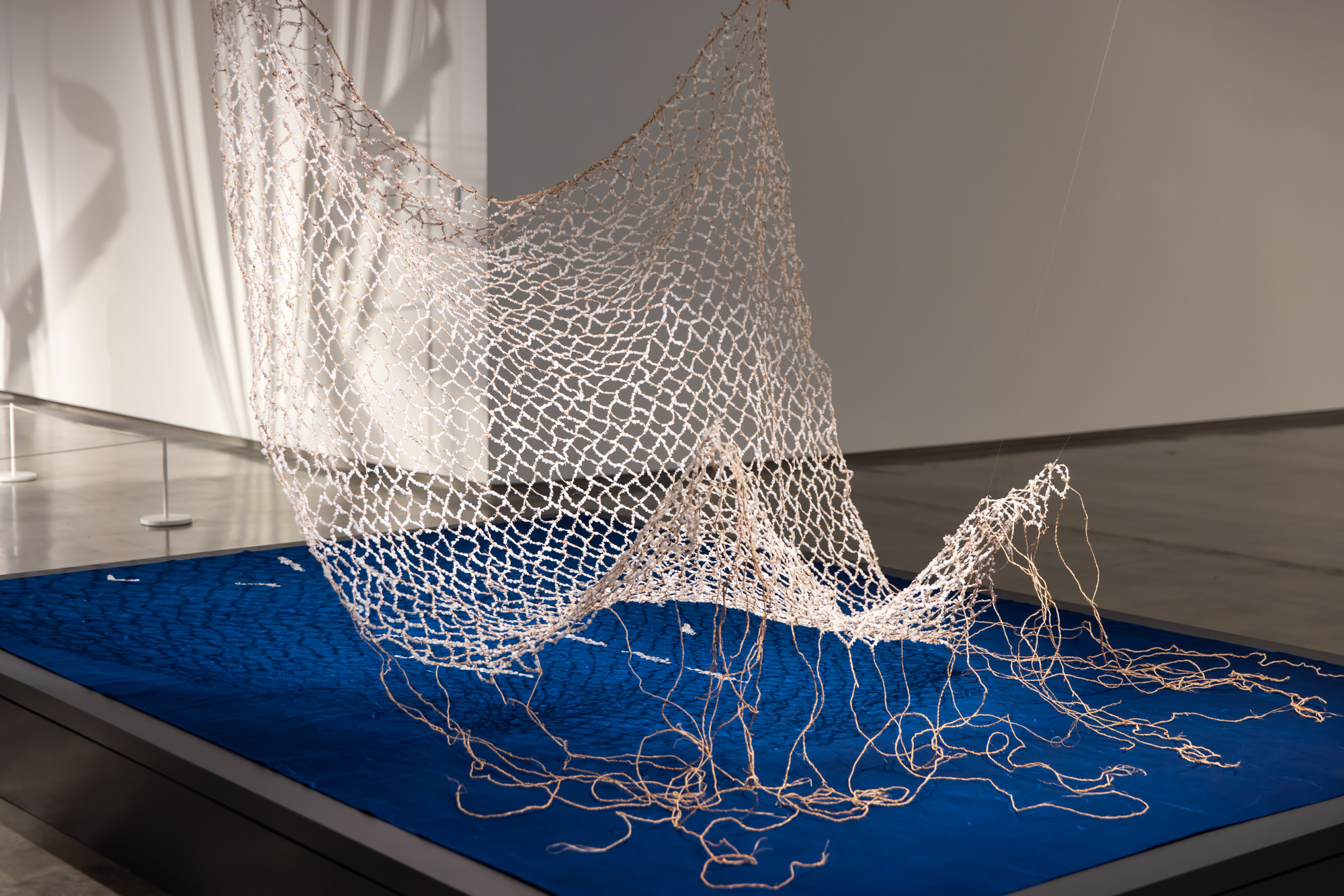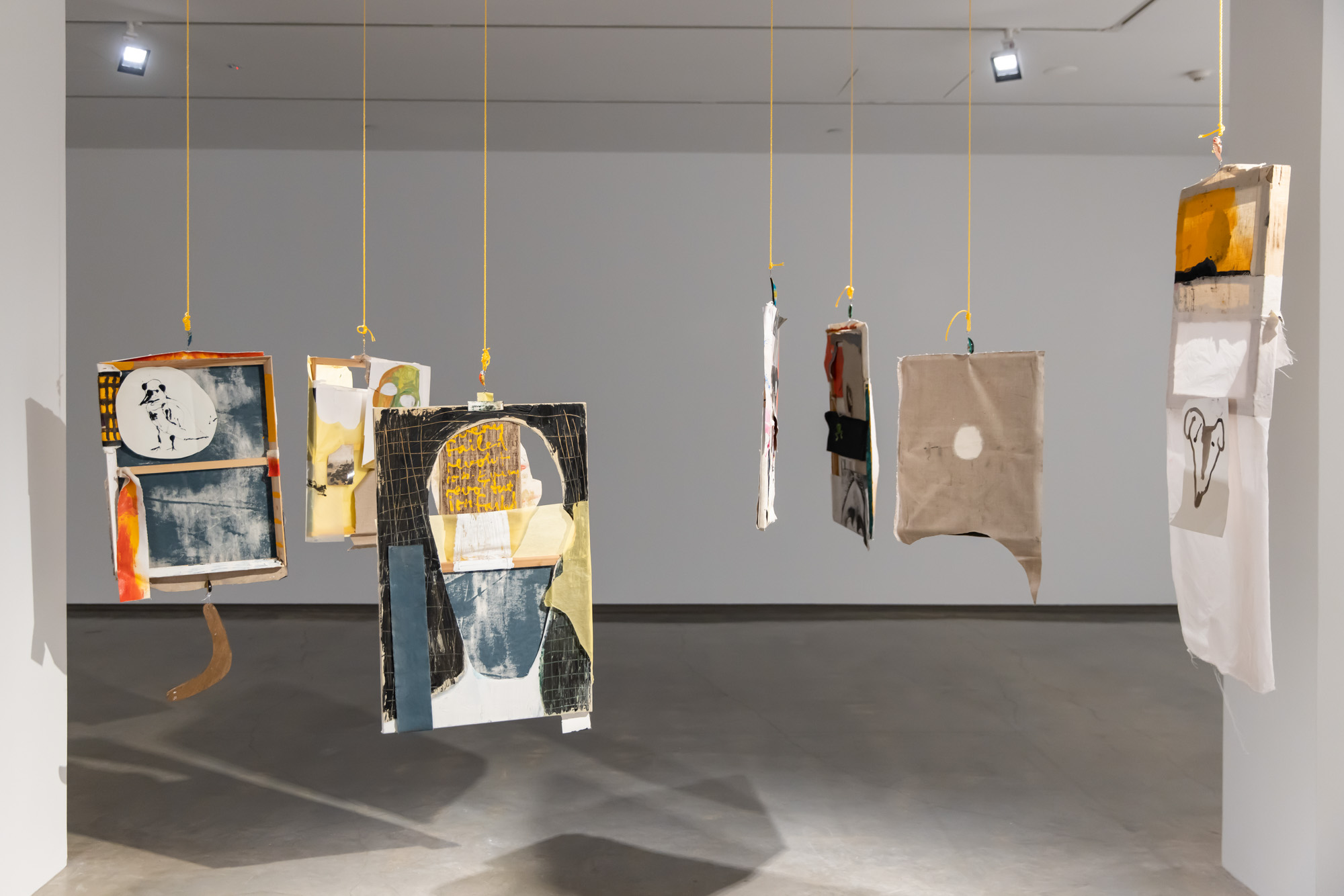Shows
“Primavera 2021: Young Australian Artists”


Shadow and movement gave the works in “Primavera 2021: Young Australian Artists” a potent aliveness, conjuring rich narratives, histories, and memories. This dynamism was achieved through visitors’ bodily interactions with the works, the mechanical activation of the pieces, the artists’ manipulation of material and form, and the body language of filmed figures.
Among the five featured artists, Hannah Gartside presented motorized spinning sculptures lovingly clothed in vintage fabrics, breathing life back into five influential, historical women: dancer Loïe Fuller, actress Sarah Bernhardt, painter Artemisia Gentileschi, tarot-card illustrator Pamela “Pixie” Colman Smith, and the mythical figure Lilith. Fuller’s famous dance performances featuring swirling plumes of fabric greatly influenced Gartside’s recent kinetic-based explorations of fabric. In tribute, Loïe (2021) is swathed in flowing, pink silk decorated with delicate, glass beads, contrasting her rigid, metal skeleton. While elegant and feminine, Gartside’s sculptures fight back against sexism. Red velvet ropes and black tassels adorning Artemisia (2021) and Sarah (2021) lashed out wildly when at peak speed. Pixie’s (2021) protests were more subtle. Her colorful strips of fabric slowly twisted and unwound, while a gloved hand slowly grazed the floor—a teasingly sensual gesture that also drew a boundary, warning visitors not to cross. One of Lilith’s guises is the serpent lurking in the biblical Garden of Eden. Gartside’s snake-like spiral of 1930s green silk moiré coiled around itself endlessly. Reminiscent of the ancient Egyptian and Greek ouroboros symbol of rebirth, Lilith (2021) became a prayer to evolve beyond sexism.

Although static, Elisa Jane Carmichael’s installation a search for meaning is to absorb the abundance of beauty in nature (2021) exuded life and the cultural memory of the artist’s Quandamooka ancestors, the Ngugi people from Moorgumpin and Minjerribah (Moreton and North Stradbroke Island). Meticulously woven strands of native talwalpin bark embellished with thousands of fish scales from the artist’s saltwater homelands were suspended mid-air. The net rose up from an inky blue cyanotype imprinted with a record of the net’s shadow. Its darker, ephemeral shadow cast in real-time by lights in the gallery added to subtle yet potent layers that revere our lands, seas, and skies.

Justine Youssef traversed more distant waters to honor their Lebanese family. They revealed the realities of immigrating to Australia and the importance of community in creating a sense of home. The artist’s two-channel video Under the table I learnt how to feed you (2019/21) intimately captures moments of their family’s life in southwestern Sydney, where thriving Lebanese communities are under threat of dispersal from gentrification. In one channel, members of Youssef’s family laugh, eat, and dance outside a bakery akin to where the artist’s mother and grandmother worked as undocumented migrants when they first arrived on Australian shores. The second screen contrastingly depicts the realities of the labor inside the bakery, where women whose faces are obscured make Lebanese bread. Like the endless revolution of Gartside’s sculptures, the migrant workers’ relentless motions alerted audiences to the exhausting inequalities within society.
The flow of fragile bodies was felt in Sam Gold’s ambitious orange, blue, charcoal, and cream ceramics. Reminiscent of coral, there is a tenderness to these organic forms, each patterned with indents that index the physical process of Gold’s hands molding the clay. Small cracks reveal the vulnerability and imperfections of the materials and our bodies. Gold’s “tactile storytelling” stems from their background in art therapy, their artistic practice becoming a cathartic tool for embodied connection and healing.

Heightened somatic awareness was also present in Dean Cross’s Prima Facie (2021) series, speaking to the artist’s training as a choreographer and dancer. His hanging cluster of seven collaged paintings invites a dynamic viewing experience, with each work moving in conversation with one another as the viewer walks around and between them. The compositions themselves had an unconventional choreography to them, comprising fragments of paintings, old photographs, a toy boomerang, and other found objects covering both sides of each canvas. They reflect Cross’s self-described “collage-like” Indigenous Worimi, Danish, and English ancestry. Like the other “Primavera” artists, his works highlight the importance of questioning conventional, often exclusionary systems through inventive ideas and perspectives.
"Primavera 2021: Young Australian Artists" was on view at the Museum of Contemporary Art Australia, Sydney, from October 1, 2021, to June 12, 2022.







